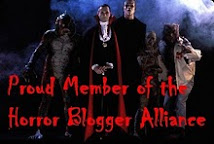1980, Dir. by Ulli Lommel.
When I write these reviews, one of the hardest things to do is find three or four images from the film that represent things I want to talk about, which I do in an effort to avoid boring you fine people with my prose. When I do this, I have to distinguish the names of the photos so I know what I'm looking for, usually naming them something like "mynameisbrucebruce" or "mynameisbrucedogbowl" (Unless I'm not reviewing My Name is Bruce, like now).
This became difficult while capturing images from Ulli Lommel's The Boogeyman. For starters, I got a first person shot that mimics Halloween, entitled "boogeymanknife". Then, I went with a picture of the lead actress being scared by a mirror, which I entitled "boogeymanmirror". I laughed, because I realized then that most of the images I'd want to use would involve a mirror, and now I had to change their names. Then I grabbed the image posted above, and tried to name it "boogeymanknife" - before being reminded by the save function that that photo already exists. It was then I realized that every scene of note - and I struggle to call any scene in this movie notable - involved a knife or mirror. It's that predictable.
The Plot
On a dark night, little Willy and Lacey are watching through the window as their young and whorish mother entertains an abusive young man. Mommy doesn't like this, and the kids end up being put to bed. They don't stay there, and soon mommy's man friend has a few stab wounds and lacks a pulse.
Then we fast forward. Lacey is married and living with her husband and his family on a farm, where Willy (pictured above), who hasn't spoken since "that night", helps out too (all while being creepy looking and having a giant jaw). But Lacey still has random bouts of terror, especially when facing mirrors, and she's soon forced to return to their childhood home by her husband (not her psychiatrist, played by horror legend John Carradine). When she gets there, she meets the kids that live there currently (whose parents are gone for the weekend, something you never want to have happen to you in a horror film), and breaks the mirror that's been in her mother's old bedroom since "that night". Her husband decides enough is enough, and brings the mirror back to the farm, putting it back together so she's forced to face it...or until it's able to kill them all. Sigh.
The Good
The film has a few good shots, even if many of them are mirror images of shots from predecessors like Halloween and Black Christmas. The musical score also is impressive at moments, but that goes away quickly, too. None of the actors break character, and are generally in frame.
That's about it.
The Bad
This section was invented for films like The Boogeyman. But I have no idea where to begin.
Well, looking at the "good" things above, problems jump out. The film obviously and blatantly mimics previous slashers, with near identical shots, an opening that's more like Carpenter's Halloween than Rob Zombie's remake was, and many other scenes that mirror better giallo films of the 1970s. The plot does diverge into a different territory with a focus late in the film on mythology of broken mirrors (really), but this change is silly and takes the film away from either a focus on real human psychology or a supernatural "boogeyman" - which is something you'd assume it would have, based on the title.
Acting across the board is bad, but that's common for a slasher film. Nicholas Love and Suzanna Love, real life siblings, play Willy and Lacey as adults, and neither is particularly competent. Ms. Love co-authored the script with director Lommel, and it's clear that the star and director were on the same page while watching the film - I'm just not sure I was while viewing it.
The musical score seemed cool at first, despite echoing Carpenter's Halloween score heavily. It grew old very, very quickly. There are two or three main themes that repeat throughout the entire film, and they seem to pop up randomly. In any scene, at any moment, there's a chance the score you've been hearing over and over for the entire 80 minutes will kick in. And drive you crazy.
There's more I could say about The Boogeyman, from its introduction of side characters that exist as victims (and worse, some characters are introduced as potential victims and then disappear from the film for good before even being used in that regard) to its hokey "open" ending that adds to the bad taste that was already left in the viewer's mouth. But I'll be nice.
Random Moments
- One more complaint: Lacey is directly involved in the actions of "that night", but is treated as innocent for the rest of the film. She's told repeatedly not to feel like it was her fault...even though it kind of was.
- The first-person scenes that evoke Halloween in the opening aren't even shot in frame. That's why I had to say "generally in frame" in my Good section. What kind of movie can't even allow me to use "The film was in frame" as a positive without being wrong? Ugh!
It's obvious by now, at least to me, that I've spent more time thinking about the ineptitude of The Boogeyman than was spent thinking about the making of the film. Billed as "the 1980 original" on new DVD packaging, which assumes it's connected to the 2005 film Boogeyman, I was hoping for at least a fun slasher that could provide some insight into that film's failures. Instead, I was reminiscing about how much I liked 2005's Boogeyman...and I didn't like 2005's Boogeyman. Just ugh. Somebody get this movie out of my head.
The Mike's Rating: RUN AWAY!








